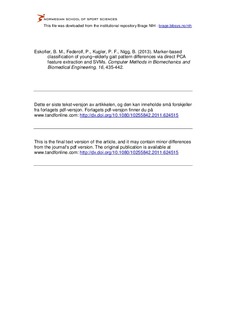| dc.contributor.author | Eskofier, Bjørn M. | |
| dc.contributor.author | Federolf, Peter | |
| dc.contributor.author | Kugler, Patrick F. | |
| dc.contributor.author | Benno, Nigg | |
| dc.date.accessioned | 2013-10-07T11:06:46Z | |
| dc.date.available | 2013-10-07T11:06:46Z | |
| dc.date.issued | 2011-12-08 | |
| dc.identifier | Seksjon for fysisk prestasjonsevne / Department of Physical Performance | |
| dc.identifier.citation | Computer Methods in Biomechanics and Biomedical Engineering. 2013, 16, 435-442 | no_NO |
| dc.identifier.uri | http://hdl.handle.net/11250/171140 | |
| dc.description | I Brage finner du siste tekst-versjon av artikkelen, og den kan inneholde ubetydelige forskjeller fra forlagets pdf-versjon. Forlagets pdf-versjon finner du på www.tandfonline.com: http://dx.doi.org/10.1080/10255842.2011.624515 / In Brage you'll find the final text version of the article, and it may contain insignificant differences from the journal's pdf version. The original publication is available at www.tandfonline.com: http://dx.doi.org/10.1080/10255842.2011.624515 | no_NO |
| dc.description.abstract | The classification of gait patterns has great potential as a diagnostic tool, for example, for the diagnosis of injury or to identify at-risk gait in the elderly. The purpose of the paper is to present a method for classifying group differences in gait pattern by using the complete spatial and temporal information of the segment motion quantified by the markers. The classification rates that are obtained are compared with previous studies using conventional classification features. For our analysis, 37 three-dimensional marker trajectories were collected from each of our 24 young and 24 elderly female subjects while they were walking on a treadmill. Principal component analysis was carried out on these trajectories to retain the spatial and temporal information in the markers. Using a Support Vector Machine with a linear kernel, a classification rate of 95.8% was obtained. This classification approach also allowed visualisation of the contribution of individual markers to group differentiation in position and time. The approach made no specific assumptions and did not require prior knowledge of specific time points in the gait cycle. It is therefore directly applicable for group classification tasks in any study involving marker measurements. | no_NO |
| dc.language.iso | eng | no_NO |
| dc.publisher | Taylor & Francis | no_NO |
| dc.subject | biomechanical data classification | no_NO |
| dc.subject | PCA feature extraction | no_NO |
| dc.subject | difference visualisation | no_NO |
| dc.subject | young–elderly gait classification | no_NO |
| dc.subject | support vector machines | no_NO |
| dc.title | Marker-based classification of young–elderly gait pattern differences via direct PCA feature extraction and SVMs | no_NO |
| dc.type | Journal article | no_NO |
| dc.type | Peer reviewed | no_NO |
| dc.subject.nsi | VDP::Technology: 500::Information and communication technology: 550 | no_NO |
| dc.subject.nsi | VDP::Medical disciplines: 700::Basic medical, dental and veterinary science disciplines: 710 | no_NO |
| dc.subject.nsi | VDP::Medical disciplines: 700::Clinical medical disciplines: 750 | no_NO |
| dc.source.journal | Computer Methods in Biomechanics and Biomedical Engineering | |
| dc.identifier.doi | 10.1080/10255842.2011.624515 | |
